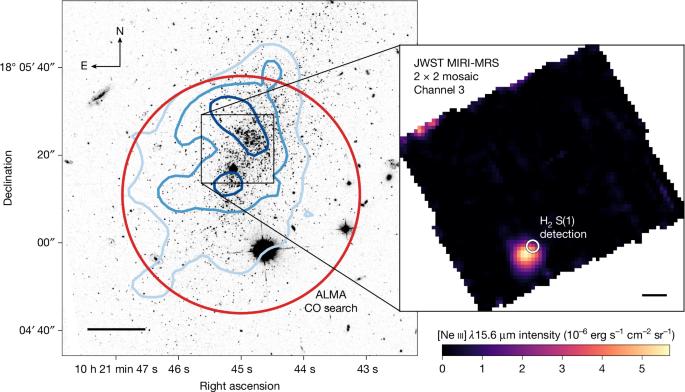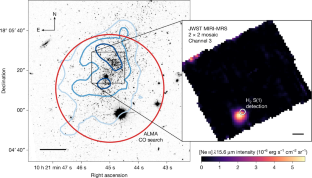在极度缺乏金属和尘埃的狮子座P星系中的氢分子
IF 48.5
1区 综合性期刊
Q1 MULTIDISCIPLINARY SCIENCES
引用次数: 0
摘要
詹姆斯·韦伯太空望远镜(JWST)揭示了早期宇宙中意想不到的快速星系聚集,与星系形成模型相矛盾1,2,3。在早期星系中典型的低丰度重元素(金属)和尘埃中,氢分子的形成及其与恒星形成的关系仍然知之甚少。一些模型预测,恒星主要是在金属含量低的原子气体中形成,而不是在金属含量高的分子气体中形成。尽管进行了多次搜索,在任何低于太阳金属量7%的星系中,还没有观测到冷分子气体。在这里,我们报告了用JWST的中红外仪器/中分辨率光谱(MIRI-MRS)观测模式探测到在3%太阳金属丰度星系狮子座P(参考文献9,10)中唯一的o型恒星附近的分子氢的旋转发射。这些观测对狮子座P的分子气体含量给出了一个下限,对O星照亮的光解区域的建模表明,这是一个致密的(半径≤2.6 pc),大约104 M⊙的云。我们还报告了阿塔卡马大型毫米/亚毫米阵列(ALMA)深度搜索中一氧化碳(CO)排放的严格上限。我们的研究结果强调了MIRI-MRS在低金属丰度条件下,即使是小的紫外线照射的分子云,在这种情况下,传统的观测示踪剂CO是没有信息的。这一发现将分子气体的金属丰度极限推低了两倍以上,为早期星系中星际介质的模型提供了至关重要的经验指导。本文章由计算机程序翻译,如有差异,请以英文原文为准。


Molecular hydrogen in the extremely metal- and dust-poor galaxy Leo P
The James Webb Space Telescope (JWST) has revealed unexpectedly rapid galaxy assembly in the early Universe, in tension with galaxy-formation models1–3. At the low abundances of heavy elements (metals) and dust typical in early galaxies, the formation of molecular hydrogen and its connection to star formation remain poorly understood. Some models predict that stars form in predominantly atomic gas at low metallicity4,5, in contrast to molecular gas at higher metallicities6. Despite repeated searches7, cold molecular gas has not yet been observed in any galaxy below 7% solar metallicity8. Here we report the detection of rotational emission from molecular hydrogen near the only O-type star in the 3% solar metallicity galaxy Leo P (refs. 9,10) with JWST’s Mid-Infrared Instrument/Medium Resolution Spectroscopy (MIRI-MRS) observing mode. These observations place a lower limit on Leo P’s molecular gas content, and modelling of the photodissociation region illuminated by the O star suggests a compact (≤2.6 pc radius), approximately 104 M⊙ cloud. We also report a stringent upper limit on carbon monoxide (CO) emission from a deep search with the Atacama Large Millimeter/submillimeter Array (ALMA). Our results highlight the power of MIRI-MRS to characterize even small ultraviolet-illuminated molecular clouds in the low-metallicity regime, in which the traditional observational tracer CO is uninformative. This discovery pushes the limiting metallicity at which molecular gas is present in detectable quantities more than a factor of two lower, providing crucial empirical guidance for models of the interstellar medium in early galaxies. Observations from the JWST MIRI-MRS instrument reveal the detection of rotational emission from molecular hydrogen near the only O-type star in the 3% solar metallicity galaxy Leo P, providing confirmation that significant quantities of molecular gas can form in such metal- and dust-poor environments.
求助全文
通过发布文献求助,成功后即可免费获取论文全文。
去求助
来源期刊

Nature
综合性期刊-综合性期刊
CiteScore
90.00
自引率
1.20%
发文量
3652
审稿时长
3 months
期刊介绍:
Nature is a prestigious international journal that publishes peer-reviewed research in various scientific and technological fields. The selection of articles is based on criteria such as originality, importance, interdisciplinary relevance, timeliness, accessibility, elegance, and surprising conclusions. In addition to showcasing significant scientific advances, Nature delivers rapid, authoritative, insightful news, and interpretation of current and upcoming trends impacting science, scientists, and the broader public. The journal serves a dual purpose: firstly, to promptly share noteworthy scientific advances and foster discussions among scientists, and secondly, to ensure the swift dissemination of scientific results globally, emphasizing their significance for knowledge, culture, and daily life.
 求助内容:
求助内容: 应助结果提醒方式:
应助结果提醒方式:


